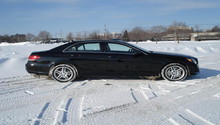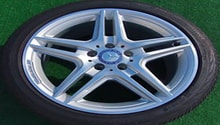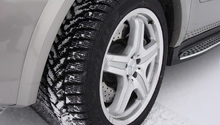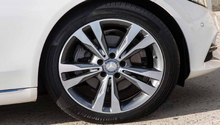Mercedes-Benz E-Class: How to Check Your Tire Tread
Read these simple instructions and tips to inspect the tires on your Mercedes-Benz E-Class. A little time as well as the change in your pocket are all it takes to keep your vehicle's steering and suspension system healthy.
This article applies to the Mercedes-Benz E-Class w211/w212 (2002-Present).
Tire tread inspection is an important part of vehicle maintenance. If the tread on your tires is worn down, you could experience a decrease in fuel economy, loss of traction, poor road performance, slow braking capability, and a possible tire blowout. And continuing to drive on uneven or excessively worn tires can become unsafe for you and your passengers; the tread is what gives your tires grip in the rain or snow, on grass or dirt, and in the mud. Read on to learn how to identify signs of tread damage quickly and effectively.

Materials Needed
- Penny
- Tread depth gauge
- Owner's manual
Step 1 – Consider a few things
To maintain optimum road performance, Mercedes-Benz recommends that your tires comply with the tread depths set by the standards of specific vehicles and E-Class models.
- In summer, tire tread should have a depth of at least 1/8", while in winter the tread depth should be at least 1/6".
- Check tire tread on a regular basis, especially prior to long trips and after seasonal changes.
- All four tires on AWD E-Class models should be replaced if one tire shows excessive tread wear. The vehicle's on-board computer reads information from the axles and differentials to adjust the amount of torque sent to each wheel accordingly. Therefore, having one tire with a higher tread depth could throw off the computer's readings and adjustments.
Step 2 – Inspect tire and check tire pressure
Observe the tire for even tread wear. In addition, make sure your tires are inflated to their appropriate air pressures because incorrect pressure levels can cause excessive tire wear. The recommended tire pressures for your vehicle can be found on the back side of the fuel door or in your owner's manual, and the recommended tire pressures for aftermarket tires can be found on their sidewalls. Uneven tread wear patterns indicate various causes:
- If a tire is worn evenly on the edges, it is under-inflated.
- If a tire shows excessive wear on the center, it is over-inflated.
- Asymmetrical wear (wear on one side of the tire) usually indicates that the tire needs an alignment.
- Excessive asymmetrical wear (with circular edges near center tread) usually indicates that the suspension is worn or bent.

(Related Article: Why Are My Tires Wearing Unevenly - MBWorld.org)
Step 3 – Check the tread depth using a coin
Place a penny into the tread grooves on several spots around the tire. Make sure Lincoln's head is upside down and facing you. If you can see all of Lincoln's head, your tread depth is less than 2/32" in and it's definitely time to replace the tire(s).

Step 4 – Check tires using a tread depth gauge
A tire tread depth gauge allows you to more accurately measure tread depths. Simply place the point of the gauge into the groove, and allow the gauge to measure the remaining tread depth of the tire. A tread depth of less than 1/8” is the usual indication that a tire change is necessary. New tires usually have about 10/32" of tire tread.

(Related Article: How to Change a Tire - MBWorld.org)
Related Discussions and Sites
- When Do You Replace Tires? - MBWorld.org
- Aftermarket Wheels & Tire Tread Question - MBWorld.org
- How Safe are Worn Tires - ConsumerReports.org
- How to Perform the Coin Test - GoodyearAutoService.com
- Tread Wear Guide - SpecialtyTire.ca






